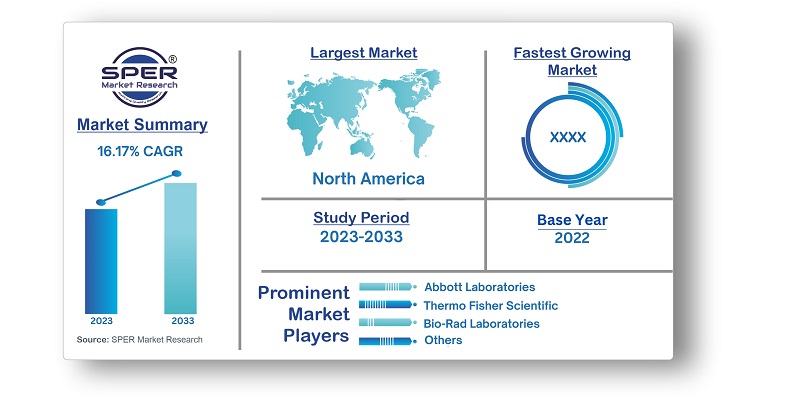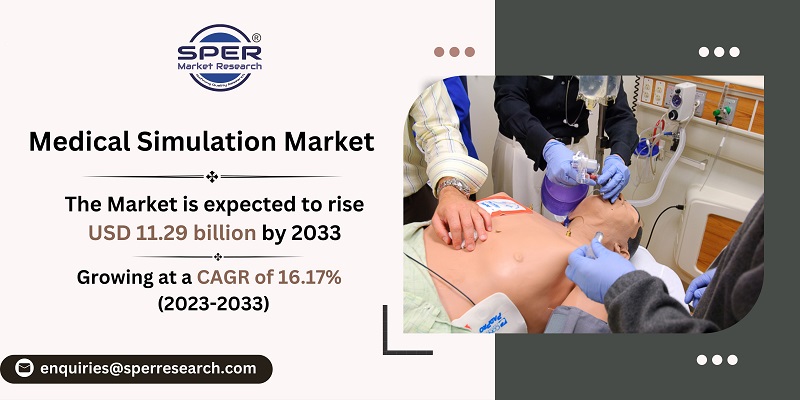
Medical Simulation Market Growth, Size, Trends, Demand, Revenue and Future Opportunities 2033
Global Medical Simulation Market Size- By Product & Services, By Method, By Technology, By Fidelity, By End-Use - Regional Outlook, Competitive Strategies and Segment Forecast to 2033
| Published: Sep-2021 | Report ID: HLCA2116 | Pages: 1 - 236 | Formats*: |
| Category : Healthcare | |||


| Report Metric | Details |
| Market size available for years | 2019-2033 |
| Base year considered | 2022 |
| Forecast period | 2023-2033 |
| Segments covered | By Product & Services, By Method, By Technology, By Fidelity, By End-Use |
| Regions covered | Asia-Pacific, Europe, Middle East and Africa, North America, Latin America |
| Companies Covered | F. Hoffmann-La Roche Ltd., Abbott Laboratories, Thermo Fisher Scientific, Inc., Agilent Technologies, Inc., Bio-Rad Laboratories, Inc., Illumina, Inc., QIAGEN N.V., Myriad Genetics, Inc., Cooper Surgical, Inc., Others. |
- Healthcare Institutes
- Medical Education Institutes
- Research Institutions and Academia
- Simulation Centers
- Others
- Global Medical Simulation Market Value Share and Forecast, By Product & Services, 2023-2033
- Anatomical Models
- Medical Simulation Software
- Simulation Training Services
- Web-based Simulation
- Global Medical Simulation Market Value Share and Forecast, By Method, 2023-2033
- Agent-based Simulation
- Discrete-event Simulation
- Monte Carlo
- System Dynamics
- Global Medical Simulation Market Value Share and Forecast, By Technology, 2023-2033
- 3D Printing
- Procedure Rehearsal Technology
- Virtual Patient Simulation
- Global Medical Simulation Market Value Share and Forecast, By Fidelity, 2023-2033
- High Fidelity
- Low Fidelity
- Medium Fidelity
- Asia-Pacific
- Europe
- Middle East & Africa
- North America
- Latin America
- Global Medical Simulation Market Size (FY’2023-FY’2033)
- Overview of Global Medical Simulation Market
- Segmentation of Global Medical Simulation Market By Product & Services (Anatomical Models, Medical Simulation Software, Simulation Training Services, Web-based Simulation)
- Segmentation of Global Medical Simulation Market By Method (Agent-based Simulation, Discrete-event Simulation, Monte Carlo, System Dynamics)
- Segmentation of Global Medical Simulation Market By Technology (3D Printing, Procedure Rehearsal Technology, Virtual Patient Simulation)
- Segmentation of Global Medical Simulation Market By Fidelity (High Fidelity, Low Fidelity, Medium Fidelity)
- Segmentation of Global Medical Simulation Market By End-Use (Academic Institutes, Hospitals, Military Organizations)
- Statistical Snap of Global Medical Simulation Market
- Expansion Analysis of Global Medical Simulation Market
- Problems and Obstacles in Global Medical Simulation Market
- Competitive Landscape in the Global Medical Simulation Market
- Impact of COVID-19 and Demonetization on Global Medical Simulation Market
- Details on Current Investment in Global Medical Simulation Market
- Competitive Analysis of Global Medical Simulation Market
- Prominent Players in the Global Medical Simulation Market
- SWOT Analysis of Global Medical Simulation Market
- Global Medical Simulation Market Future Outlook and Projections (FY’2023-FY’2033)
- Recommendations from Analyst
1.1. Scope of the report1.2. Market segment analysis
2.1. Research data source2.1.1. Secondary Data2.1.2. Primary Data2.1.3. SPER’s internal database2.1.4. Premium insight from KOL’s2.2. Market size estimation2.2.1. Top-down and Bottom-up approach2.3. Data triangulation
4.1. Driver, Restraint, Opportunity and Challenges analysis4.1.1. Drivers4.1.2. Restraints4.1.3. Opportunities4.1.4. Challenges4.2. COVID-19 Impacts of the Global Medical Simulation Market
5.1. SWOT Analysis5.1.1. Strengths5.1.2. Weaknesses5.1.3. Opportunities5.1.4. Threats5.2. PESTEL Analysis5.2.1. Political Landscape5.2.2. Economic Landscape5.2.3. Social Landscape5.2.4. Technological Landscape5.2.5. Environmental Landscape5.2.6. Legal Landscape5.3. PORTER’s Five Forces5.3.1. Bargaining power of suppliers5.3.2. Bargaining power of buyers5.3.3. Threat of Substitute5.3.4. Threat of new entrant5.3.5. Competitive rivalry5.4. Heat Map Analysis
6.1. Global Medical Simulation Market Manufacturing Base Distribution, Sales Area, Product Type6.2. Mergers & Acquisitions, Partnerships, Product Launch, and Collaboration in Global Medical Simulation Market
7.1. Global Medical Simulation Market Value Share and Forecast, By Product & Services, 2023-20337.2. Anatomical Models7.3. Medical Simulation Software7.4. Simulation Training Services7.5. Web-based Simulation
8.1. Global Medical Simulation Market Value Share and Forecast, By Method, 2023-20338.2. Agent-based Simulation8.3. Discrete-event Simulation8.4. Monte Carlo8.5. System Dynamics
9.1. Global Medical Simulation Market Value Share and Forecast, By Technology, 2023-20339.2. 3D Printing9.3. Procedure Rehearsal Technology9.4. Virtual Patient Simulation
10.1. Global Medical Simulation Market Value Share and Forecast, By Fidelity, 2023-203310.2. High Fidelity10.3. Low Fidelity10.4. Medium Fidelity
11.1. Global Medical Simulation Market Value Share and Forecast, By End-Use, 2023-203311.2. Academic Institutes11.3. Hospitals11.4. Military Organizations
12.1. Global Medical Simulation Market Size and Market Share
13.1. Global Medical Simulation Market Size and Market Share By Product & Services (2019-2026)13.2. Global Medical Simulation Market Size and Market Share By Product & Services (2027-2033)
14.1. Global Medical Simulation Market Size and Market Share By Method (2019-2026)14.2. Global Medical Simulation Market Size and Market Share By Method (2027-2033)
15.1. Global Medical Simulation Market Size and Market Share By Technology (2019-2026)15.2. Global Medical Simulation Market Size and Market Share By Technology (2027-2033)
16.1. Global Medical Simulation Market Size and Market Share By Fidelity (2019-2026)16.2. Global Medical Simulation Market Size and Market Share By Fidelity (2027-2033)
17.1. Global Medical Simulation Market Size and Market Share By End-Use (2019-2026)17.2. Global Medical Simulation Market Size and Market Share By End-Use (2027-2033)
18.1. Global Medical Simulation Market Size and Market Share By Region (2019-2026)18.2. Global Medical Simulation Market Size and Market Share By Region (2027-2033)18.3. Asia-Pacific18.3.1. Australia18.3.2. China18.3.3. India18.3.4. Japan18.3.5. South Korea18.3.6. Rest of Asia-Pacific18.4. Europe18.4.1. France18.4.2. Germany18.4.3. Italy18.4.4. Spain18.4.5. United Kingdom18.4.6. Rest of Europe18.5. Middle East and Africa18.5.1. Kingdom of Saudi Arabia18.5.2. United Arab Emirates18.5.3. Rest of Middle East & Africa18.6. North America18.6.1. Canada18.6.2. Mexico18.6.3. United States18.7. Latin America18.7.1. Argentina18.7.2. Brazil18.7.3. Rest of Latin America
19.1. 3D Systems, Inc.19.1.1. Company details19.1.2. Financial outlook19.1.3. Product summary19.1.4. Recent developments19.2. CAE Healthcare Inc.19.2.1. Company details19.2.2. Financial outlook19.2.3. Product summary19.2.4. Recent developments19.3. Cardionics19.3.1. Company details19.3.2. Financial outlook19.3.3. Product summary19.3.4. Recent developments19.4. Gaumard Scientific19.4.1. Company details19.4.2. Financial outlook19.4.3. Product summary19.4.4. Recent developments19.5. Intelligent Ultrasound (Medaphor Ltd.)19.5.1. Company details19.5.2. Financial outlook19.5.3. Product summary19.5.4. Recent developments19.6. Kyoto Kagaku Co., Ltd.19.6.1. Company details19.6.2. Financial outlook19.6.3. Product summary19.6.4. Recent developments19.7. Laerdal Medical19.7.1. Company details19.7.2. Financial outlook19.7.3. Product summary19.7.4. Recent developments19.8. Limbs & Things Ltd.19.8.1. Company details19.8.2. Financial outlook19.8.3. Product summary19.8.4. Recent developments19.9. Medical X19.9.1. Company details19.9.2. Financial outlook19.9.3. Product summary19.9.4. Recent developments19.10. Mentice AB19.10.1. Company details19.10.2. Financial outlook19.10.3. Product summary19.10.4. Recent developments19.11. Operative Experience, Inc.19.11.1. Company details19.11.2. Financial outlook19.11.3. Product summary19.11.4. Recent developments19.12. Simulab Corporation19.12.1. Company details19.12.2. Financial outlook19.12.3. Product summary19.12.4. Recent developments19.13. Åžimulaids19.13.1. Company details19.13.2. Financial outlook19.13.3. Product summary19.13.4. Recent developments19.14. Surgical Science Sweden AB19.14.1. Company details19.14.2. Financial outlook19.14.3. Product summary19.14.4. Recent developments19.15. Virtamed AG19.15.1. Company details19.15.2. Financial outlook19.15.3. Product summary19.15.4. Recent developments19.16. Others
SPER Market Research’s methodology uses great emphasis on primary research to ensure that the market intelligence insights are up to date, reliable and accurate. Primary interviews are done with players involved in each phase of a supply chain to analyze the market forecasting. The secondary research method is used to help you fully understand how the future markets and the spending patterns look likes.
The report is based on in-depth qualitative and quantitative analysis of the Product Market. The quantitative analysis involves the application of various projection and sampling techniques. The qualitative analysis involves primary interviews, surveys, and vendor briefings. The data gathered as a result of these processes are validated through experts opinion. Our research methodology entails an ideal mixture of primary and secondary initiatives.



Frequently Asked Questions About This Report
PLACE AN ORDER
Year End Discount
Sample Report
Pre-Purchase Inquiry
NEED CUSTOMIZATION?
Request CustomizationCALL OR EMAIL US
100% Secure Payment






Related Reports
Our Global Clients
Our data-driven insights have influenced the strategy of 200+ reputed companies across the globe.




















